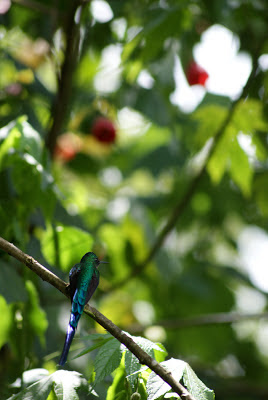
As the jeep bounced along, overflowing with tourists and
Colombians, I felt a tad underdressed. The other white folk had donned hiking
boots, rubber galoshes, and carried plastic ponchos in preparation for the
day’s trek. I was sporting my usual flipflops and yoga-inspired clothes (read:
comfortable), my only actual shoes, in fact a pair of much-underused running
shoes, waiting patiently, still packed away in my backpack in Ocaña. So, as the
jeep jerked to a halt, there I sat, flipflop-clad but ready to hike.
A rutted dirt road led us down into Cocora Valley, past a
trout hatchery and weaving between cow-specked farmlands. Towering wax palms
dotted the hillside, stretching up surreally from otherwise treeless fields and
hills, reaching as though they could brush the azure of the bright morning sky.
The road, a mere track only passable for humans and their equine friends,
carried us onward, graciously dipping into patches of shade as it headed toward
a lush cloud forest.
The landscape changed abruptly and dramatically as the trail
dumped us, reeling, from the illuminated fields into the dense, shadowy tree
cover. Ancient trees, some laden with leaves the size of your face, tangled
overhead, offering respite from the nearly-midday sun. With the shade came the trail’s
inability to recover from the previous day’s rain. The mud, mixed with
ever-present horse droppings, forced me to spring from rock to rock, searching
out dry spots for my exposed feet, where others could simply tromp along the
trail how they pleased.
Back and forth, up and over, the trail wound through the
dense vegetation. Here and there we crisscrossed a river as it tumbled toward
the valley behind us, swaying precariously on one person suspension bridges.
Waiting as, one-by-one we bottlenecked behind another gringo cluster, a
butterfly alighted on my bare toes. He even stuck with me for several steps.
Disclaimer: Though I felt blessed at the time, as I always
feel when a butterfly chooses me as a temporary resting place, these
butterflies would turn out to be a bizarrely friendly variety.
Following our hummingbird hangout at
Acaime Natural Reserve,
we stopped for a cheese-and-crackers lunch on the return hike. Perched along
the river bank, we happened upon a massive kaleidoscope of butterflies. (I
thank science for this bit of beauty, as ‘kaleidoscope’ is actually a proper
name for a group of butterflies.)
Clustered about muddy pools collecting in the rocks
alongside the river, their sheer numbers made the ground look as though it were
ready to take off all at once with the whisper of so many delicate wings. Not
only did the butterflies flutter about my toes, but they seemed genuinely to
lack typical butterfly skittishness. Perhaps drawn by the salt of crackers and
sweat, they climbed onto our outstretched hands, flitted about our hair, and
even ventured an exploratory journey onto our noses.
Though, as infatuated as they were with us, and we with
them, the spell was broken with the muddy, stomping intrusion of a stray dog
looking to share our lunch. The dog quickly took up the role of new friend,
joining us for the remainder of the hike back through the cloud forest. He
trotted along ahead, fur shining in as he tromped through patches of sunlight,
stopping every so often to glance back and make sure we silly humans were still
following the path he bravely laid out for us.
Though he too parted ways with us, leaving us as the cloud
forest trickled out and gave way to the rolling hills and wax palms of the
valley, we were left with the sweet afterglow of a day spent in the embrace of
nature. Even if that embrace left my feet a bit filthy.



















































